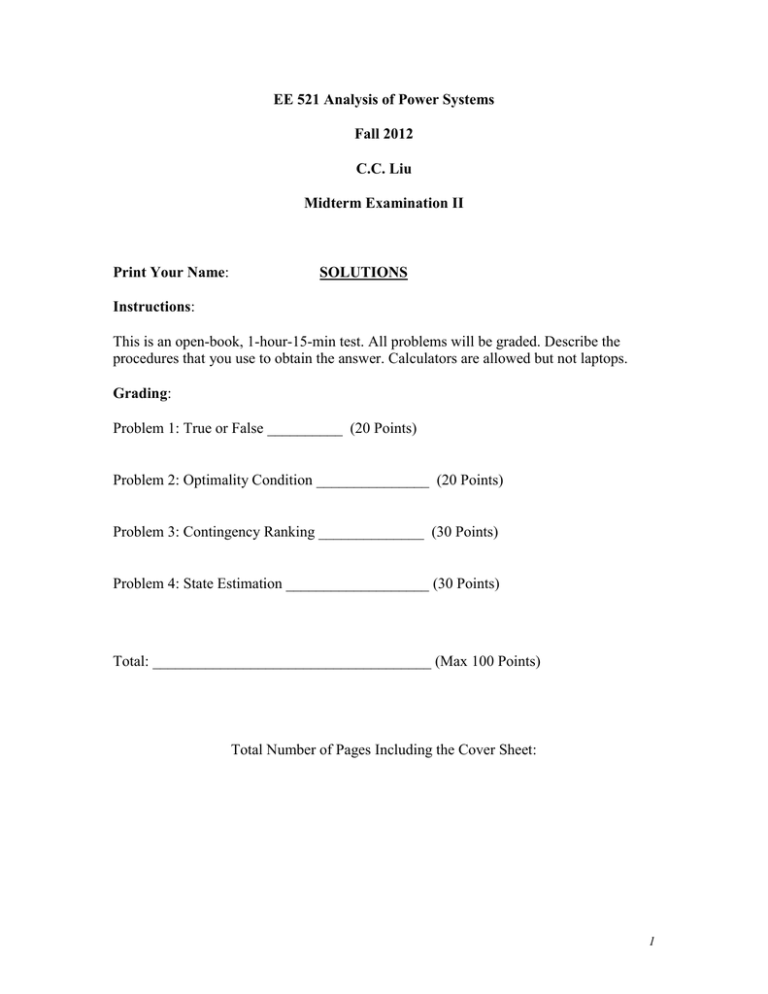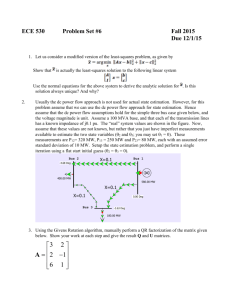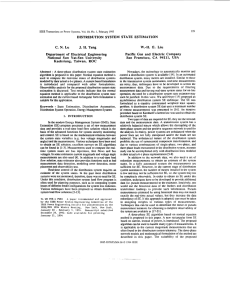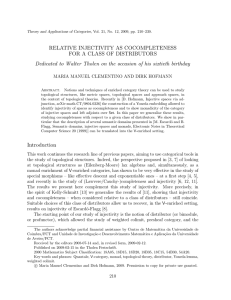Even though there are two lines out of service in the WSCC power
advertisement

EE 521 Analysis of Power Systems Fall 2012 C.C. Liu Midterm Examination II Print Your Name: SOLUTIONS Instructions: This is an open-book, 1-hour-15-min test. All problems will be graded. Describe the procedures that you use to obtain the answer. Calculators are allowed but not laptops. Grading: Problem 1: True or False __________ (20 Points) Problem 2: Optimality Condition _______________ (20 Points) Problem 3: Contingency Ranking ______________ (30 Points) Problem 4: State Estimation ___________________ (30 Points) Total: _____________________________________ (Max 100 Points) Total Number of Pages Including the Cover Sheet: 1 Problem 1: True or False (20 Points) Please add problem 1 2 Problem 2: Optimality Condition (30 Points) A basic economic dispatch problem with 2 generators in the same power plant is formulated as an optimal power flow problem. The fuel cost curves of all generator units are assumed to be quadratic, i.e., Min ∑ 5*P12 + 10* P22 s.t. P1 + P2 = 100 MW 1 < P1 < 60 Find 𝑃1 , 𝑃2 & all values of multipliers. Solve by Newton's method. (a) No inequality condition (b) Add 𝑃1 = 1 (c) Add 𝑃1 = 60 Solution: (a) L = 5P12 + 10P22 + λ1 (100 − 𝑃1 − 𝑃2 ) ∇𝑃1 L = 10P1 − λ1 ∇𝑃2 L = 20P2 − λ1 (b) 3 Problem 3: Contingency Ranking (30 Points) A 3-bus power system is shown below: 1 1 0.1 rad jx j1 3 jx j1 jx j1 2 3 0 (ref. bus) 2 0.3 rad All quantities are in per unit. Use the DC load flow method for this problem. The angles shown above are the base case values. The performance index for the contingencies is defined by 1 P PI liml it l 1 2 Pl L 2 Where L is the total number of lines (=3). The line flow limit for all lines is Pl limit 1 p.u. Bus 3 is the reference bus for the DC load flow. Note that the flow Pl is a function of the angle difference. Suppose the line outages are being evaluated by the ‘Adjoint Network’ method. 4 Solution: (a) Calculate the PI value for the base case. b) Solve the adjoint network DC load flow to find ˆ . 5 Problem 4: State Estimation (30 Points) The one-line diagram of a power system is shown below. G1 G2 M2 Bus1 Bus2 M1 Bus3 Bus4 M3 All transmission lines have the same reactance X = j0.1pu, and the standard deviation of T all meters is given by σ = 0.01. Assume that the state vector is 2 3 4 and θ1 = 0. a) Write down the measurement matrix H with the 3 meters. Solution: 𝜃1 − 𝜃2 −𝜃2 𝑃12 = = 𝑋12 𝑋12 𝑃2 = 𝜃2 − 𝜃1 𝜃2 − 𝜃4 1 1 −1 + =( + ) 𝜃2 + ( )𝜃4 𝑋21 𝑋24 𝑋21 𝑋24 𝑋24 𝑃3 = 𝜃3 − 𝜃1 𝜃3 − 𝜃4 1 1 −1 + =( + ) 𝜃3 + ( )𝜃4 𝑋31 𝑋34 𝑋31 𝑋34 𝑋34 𝐻= ( −1 𝑋12 0 1 1 + 𝑋21 𝑋24 0 0 1 1 + 𝑋31 𝑋34 0 −10 −1 = ( 20 𝑋24 0 −1 𝑋34 ) 0 0 0 −10) 20 −10 6 b) Calculate the best estimates of bus angles. Assume that Z measure is given by: Z1 0.210 Zmeasure Z 2 0.028 pu Z 0.180 3 Solution: 𝜃̂2 −0.0210 𝜃̂ = [𝜃3 ] = (𝐻 𝑇 𝑅 −1 𝐻)−1 𝐻 𝑇 𝑅 −1 𝑍𝑚𝑒𝑎𝑠𝑢𝑟𝑒 = [−0.0286] −0.0392 𝜃̂3 c) Due to the failure of a remote terminal unit at Bus 2, meter M2 is out of service. Is the system observable with the two remaining meters? Justify your answer step-by-step. Solution: 𝑃12 = 𝑃3 = 𝜃1 − 𝜃2 −𝜃2 = 𝑋12 𝑋12 𝜃3 − 𝜃1 𝜃3 − 𝜃4 1 1 −1 + =( + ) 𝜃3 + ( )𝜃4 𝑋31 𝑋34 𝑋31 𝑋34 𝑋34 𝐻= ( −1 𝑋12 0 0 1 1 + 𝑋31 𝑋34 0 −1 𝑋34 ) −10 0 =( 0 20 0 ) −10 Rank of H is 2 so H has full row rank. However, 2 𝑅 = (0.01 0 0 ) 0.012 1000000 𝐻 𝑇 𝑅 −1 𝐻 = ( 0 0 0 4000000 −2000000 0 −2000000) 1000000 Since 𝐻 𝑇 𝑅 −1 𝐻 is 3 by 3 matrix and has a rank of 2. So it is singular, i.e. det(HTR-1H)=0. Therefore, the state estimation cannot be solved and the system is unobservable. 7










